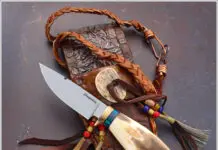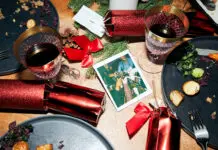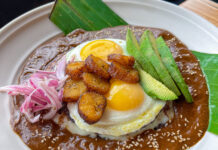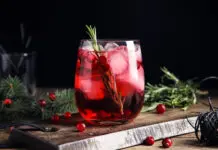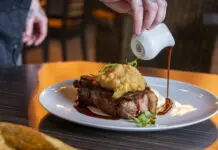Sometimes a restaurant is the fulfillment of a lifetime dream. You can usually tell when this is the case. Every dish is lavished with years of thought and care, every detail planned, flavors pop as you taste food that’s been years in the planning. And so it is with Daigoro.
Phillip Phillips, said restaurant’s owner, grew up in Cleveland and Sand Springs.
“Both of my grandmas were avid cooks,” he recalls. “They cooked meals for us three times a day and all family gatherings centered around cooking. This stayed with me.”
Later on, Phillips married Danielle, who became his life and business partner, and found his calling in restaurant kitchens. He never went to cooking school, but instead learned from fine dining chefs who, years before Tulsa’s culinary renaissance, were turning out the finest dishes in Tulsa: Steven Howard of Kokoa, Geoffrey van Glabbeek of Lava Noshery, and Zahidah Hyman of Keo.
After learning from these and other mentors, he wanted to open his own restaurant but couldn’t afford it. Instead, he put those dreams on hold and moved to Austin to play in a band. Right near his apartment, there was a parking lot full of food trucks.
“They all served incredibly exciting food,” he says. “It was chef-driven and affordable, and they were boldly, brightly painted. I became obsessed.”


Best of all, he says, you could start a business for under $10,000. Phillips found a sturdy old 1982 truck in Oklahoma City and his culinary journey began. But what to cook? Thinking back to life on the road, Phillips remembered a delicious banh mi shop in California.
“They didn’t use traditional recipes, they used lots of different aioli and cool pickles and sauces,” he says. “It was life-changing, the harmony of flavor profiles.”
And indeed it did change the Phillips’ lives. Back in Tulsa, Phillip immediately started inventing recipes, testing them on his friends. One night, they parked the food truck outside a local bar. The restaurant – called Lone Wolf Banh Mi – sold out in two hours and from there, rocketed to success.
Ten years and two successful restaurants later, the Phillips family appeared to have it all. But Phillip missed the unfettered creativity of the chefs he’d trained with.
“One day,” he told an interviewer in 2017, “I’ll have a place where all I do is create.”
Flash forward to today. Go to 21st and Riverside in Tulsa and you’ll see a sleek, streamlined dining hall built on pilings over the rushing Arkansas River. The building used to be Blue Rose, but about two years ago it was up for sale.
“Standing on the balcony, watching the river,” says Phillips, “we knew that this was our chance.”
And then came two years of hard work. Phillips, himself a design student, teamed up with architect Chris Lilly and, along with Danielle, spent ten months nailing down the design. Simultantously, the Phillipses planned the menu.
“I was trying to do things never seen before,” he says. They ate their way through every major U.S. city looking for inspiration. At one point, they caught word of a dish made with shrimp and Malaysian baby cereal. Days of research led to such a dish, prepared by street vendors in Singapore. This became a prized – and surprisingly delicious – dish on the menu. But it’s about the only dish that Phillips copied.
“I’ve been an artist my whole life,” he says. “Copying doesn’t inspire me, creating does.”
Asked to describe Daigoro, Phillips thinks a moment and then says: “We’re a non-traditional, pan-Asian smoke house with primary roots in Japanese cuisine.”
Brisket, pork belly, ribs, chicken wings and corn all, indeed, find their way to the smoker. The ribs are smoked, glazed in Korean BBQ sauce, topped with cilantro, mint and serrano. The cucumber salad, Phillips describes, is “unassuming, but there’s a lot going on.” Cool, refreshing with much depth and flavor, it makes a good start to any meal. The shaking beef, their version of Vietnamese Bo Luc Lac, was something Phillip often cooked for his family.
“My kids insisted it be on the menu,” he says. “And,” he adds, “the menu is not stagnant. I have ten new dishes I’m working on right now.”






Featured photo credit: Hamachi, or yellowtail fish, comes with yuzu ponzu, blood orange and serrano. All photos courtesy Daigoro



